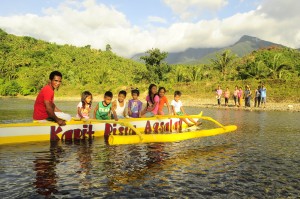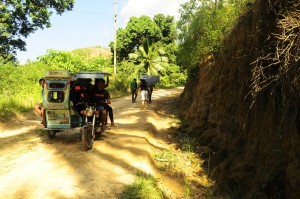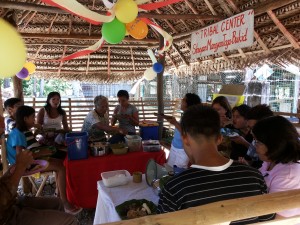In the core of the Philippine culture is the value of unity and togetherness best exhibited in the practice of bayanihan.
The term bayanihan means helping one’s neighbor to make a difficult task less demanding. Most of the time it is featured as a group of men transporting a bahay-kubo, the traditional Filipino house, on their shoulders. The act is a demonstration of a community spirit, an admirable display of solidarity and teamwork, traits that are now threatened towards extinction.
Such feats are now uncommon. Except in the remote municipality of Magdiwang, Romblon.
Reviving the lost culture of bayanihan
Found in the heart of the Philippine archipelago is the crescent-shaped Sibuyan Island.
Famous for its rich natural biodiversity and scenic landscapes, Sibuyan Island is a pearl in the seas of Romblon province. Aside from this, the island became more prominent in the mountaineering community for the perilously challenging climb of Mt. Guiting-Guiting.
This abundance in natural wonders parallels the island’s wealth of big-hearted people.
In Magdiwang, one of the three municipalities in the island, is where the timeworn value of bayanihan is currently in revival. Residents have started to work together in resolving issues that affects their communities and barangays.
Organizing communities, organizing change
Magdiwang is one of the three municipalities of Sibuyan Island and is the first in the region of MIMAROPA to apply Community Organizing as part of the KALAHI-CIDSS program.
KALAHI-CIDSS or Kapit-Bisig Laban sa Kahirapan Comprehensive and Integrated Delivery of Social Services is one of the core poverty alleviation programs of the Department of Social Welfare and Development.
Through the program, communities are granted the resources and the responsibility over planning, implementing and maintaining sub-projects that address their needs. In employing the community organizing approach however, communities are at liberty to solve their problems with their own resources, skills and creativity through the guidance of Community Empowerment Facilitators (CEFs).
To provide the necessary assistance and support, CEFs immerse themselves in the communities to know their culture and lifestyle. They visit residents and engage them in conversations, participate in community activities and stay with them in their homes.
Through this, CEFs get a glimpse of the people’s daily struggles and the problems that cause their hardships. After identifying their problem, the CEFs’ goal is to empower the residents and motivate them to act.
A boat ride to safety
In barangay Jao-Asan, residents have to cross a river to reach the town proper. Though perfectly safe in the summer when the water barely reaches their knees, the river swells and reaches at least 10 feet high when the rainy season comes. The risks of river crossing in these times hinder the transportation of their farm produce and deter residents from going to work and students from going to school.
Another problem the residents identified is the worn-out bridge that has already caused accidents. Several children and a carabao have fallen from the bridge and were injured.
To address this, residents of Sitio Agsalay collected contributions from each household and solicited aid for the construction of a boat and the renovation of the old bridge.
According to Janice Fabila, one of the volunteers, “maraming taon ang lumipas ng hindi napapansin at naaayos ang aming suliranin (many years have passed and our problems are ignored and were never remedied)”.
The boat, operated through a pulley system since it would be difficult to row through the strong river current, would transport residents across the river. Through their efforts, the old bridge was also reconstructed and now offers safe passage for the residents, children, animals and even motorcycles.
During the blessing of these community projects on May 5, 2016, the municipal Mayor Hon. Guillermo Rocha acknowledged the efforts of the community and committed to fixing the bridge and giving the community a hundred meter hanging bridge to replace the boat that would amount to at least P2.5 million as estimated by the Technical Facilitator of the Kalahi-CIDSS Area Coordinating Team of Magdiwang.
Safe crossing. Children ride the boat across the river while their mothers wait on the other side
On the road to change
In Barangay Dulangan, a different set of challenges were met with a different set of solutions but with the same eagerness for change.
A staggering one hundred twenty people including Pantawid Pamilyang Pilipino Program beneficiaries and Indigenous People worked together in creating a road from what used to be a narrow man-made trail. The nearly 150 m. road was done in three 2-hour periods during Saturdays.
“Parang mga langgam yung mga nagtatrabaho noon (They were like ants when they were working)”, Helen Marin, one of the volunteers who led the bayanihan, said jokingly as she explained how the people worked together, some hauling rocks, sand and gravel while others cleaned the path.
About 42 households will directly benefit from the road, including a family with a physically disabled child who had previously dealt with difficulties in transportation.
“Marami ng nakakapasok na mga nagtitinda at nakakapagbaba ng mga ani galing sa bukid (Many sellers can go inside and harvests can be brought down from farms)”, said Helen.
The once narrow trail now have the capacity for a tricycle that will carry their farm produce.
The clearing of several parts of their road in Sitio Franco that were buried in small-scale landslides because of Typhoon Nona were also undertaken by the affected barangay residents and thus solving their problems in transportation.
In the process, they also dug up canals in the side of the road which was needed to keep water from accumulating in the middle.
Recognizing the determination of the community, the concreting of the road was included in the municipality’s Annual Investment Plan for 2017, allotting P200,000 for its construction.
The barangay is also cut across in several places by stretches of rivers and the residents found difficulty in crossing some parts especially when they have to transport goods to the town and vice versa.
In response to this dilemma, they have decided to construct a temporary spillway.
The 40 m. spill way was built in 2 hours by at least 80 residents composed of men, women and children, who hauled large rocks and created a form of bridge that connects the roads across each river bank.
In the approaching rainy season, the temporary spillway is in danger of being carried away by strong river currents but their hard work will not go to waste. This effort has earned them the promise of a P1.6 M concrete spillway to be included in the Bottom-up Budgeting (BuB) program.
Vehicles pass without difficulty on newly cleared road of Sitio Franco
Involving the youth
When typhoon Nona struck, it brought destruction to the communities in the municipality. This included the basketball court of Barangay Poblacion.
Ruined and covered in sand, the youth were unable to use it and resorted to computer games and other unhealthy activities.
Until a small group of teenagers decided to organize a clean-up and solicited sports equipment from the local officials who were generous enough to heed their request.
“Di kami makapaniwala na nakausap namin si SB Ado Villanueva at Kagawad Noriel Rollon para sa pangangailangan naming mga kabataan. Natuto kaming makipag-usap sa mga taong may katungkulan sa gobyerno. (We can’t believe that we can talk to the SB and Kagawad for the needs of the youth. We learned to talk to people in the government)”, one of the youngsters said.
It was also in this Barangay where the mothers were mobilized to conduct a community clean-up against dengue after a recent outbreak of the disease in January.
According to them, this was the very first time that they had a bayanihan. But the experience was both challenging and enlightening for both the mothers and the youth.
“Ngayon lang namin na-realize na may magagawa pala kami para makatulong sa komunidad. Malaking bagay pala talaga pag nagkaka-isa (It is only now that we realize that we can do something for our community. Unity is really very important),” reflected one of the mothers.
Fly high. The youth of Brgy. Poblacion enjoy a ballgame after their clean-up
A gathering place for IPs
The lack of meeting or gathering place has been the problem of the women of Barangay Ipil for months. As beneficiaries of the Modified Conditional Cash Transfer (MCCT) for IPs, they needed an area where they are able to meet and hold activities.
They decided to take action and build a temporary cluster house, a small bahay kubo made of wood and indigenous materials.
The cluster house was constructed with the help of the women’s husbands. “Tuwing araw ng lingo pumupunta kaming lahat dito kasama ang mga asawa namin (On Sundays we go here with our husbands), said Cristina Ruado, the Parent Leader of the MCCT IPs.
While their husbands created the foundation, the women were tasked to weave coconut leaves for the roof.
All the materials used were from each of the members who were tasked in the beginning of their project, therefore minimizing their expenses. The barangay showed their support by lending them the land where the temporary cluster house is now erected.
The task was completed in four weeks even though the women were at first unsure whether they would be able to convince their husbands to help.
The experience was definitely a memorable one for the women and their husbands. “Habang nagtatrabaho, masaya kami, kahit mainit nagkekwentuhan kami ng masasaya (We were happy while working, even though it’s hot, we chat about happy things)”, recalls Leticia Burac, one of the volunteers.
The women of Brgy. Ipil and Kalahi-CIDSS staff share a meal during the blessing of their cluster house (Photo from ACT Magdiwang)
Bayanis on the rise
These are only a few of the bayanihans of the residents of Magdiwang.
In Barangay Agutay, they are planning to install street lights and construct a basketball court. Negotiations with the governor are ongoing for an irrigation system for the farmers of Barangay Ambulong.
Their efforts are also acknowledged by the local government. Barangay Tampayan was given two jetmatic pumps from the LGU and four comfort room units from the Rural Health Unit for the benefit of more than one hundred residents.
It has been common practice that small problems in society are ignored or blamed to the government’s incompetence. But in the Municipality of Magdiwang, people have taken responsibility for their communities, proving that with unity, they are able solve problems that have long burdened them. With their own hands and the spirit of bayanihan, they have accomplished goals that at first seemed impossible.
![]()






